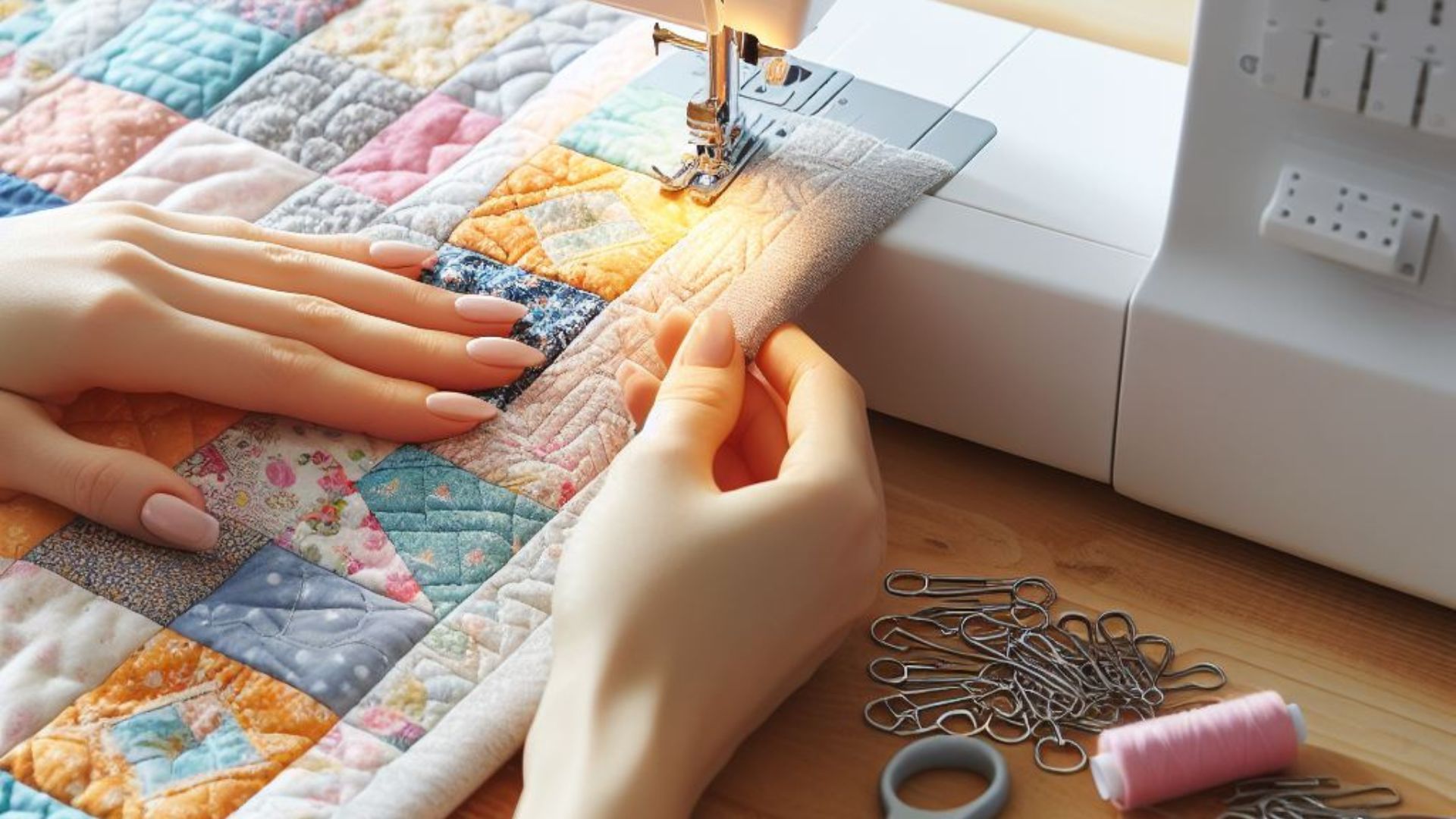Absolutely, quilting by hand is a timeless and rewarding craft that allows you to create beautiful, unique pieces.
Let’s dive into the process of hand quilting and explore its benefits, techniques, and tips to get you started on your quilting journey.
Hand Quilting: A Time-Honored Craft
Quilting by hand is a cherished tradition that connects us to generations past. While sewing machines offer efficiency, hand quilting adds a personal touch and allows for intricate designs and details.
Getting Started with Hand Quilting
Materials You’ll Need:
Before beginning your hand quilting adventure, gather these essentials:
- Fabric: Choose quality fabric for your quilt top, backing, and batting (the middle layer).
- Needles: Select quilting needles designed for hand quilting.
- Thread: Use a sturdy thread that complements your fabric.
- Quilting Hoop/Frame: Helps keep your fabric taut while quilting.
Techniques for Hand Quilting
1. Basting:
Secure the layers of your quilt sandwich (top, batting, and backing) together. This can be done with safety pins or basting stitches.
2. Hand Quilting Stitches:
- Running Stitch: Basic and versatile, ideal for outlining shapes or creating geometric patterns.
- Backstitch: Offers more durability, useful for stronger seams.
- Rocking Stitch: Creates small, even stitches with a rocking motion of the needle.

Hand Quilting
3. Quilting Patterns:
Experiment with various patterns like stippling, feathers, or straight lines. Use stencils or freehand drawing to guide your stitches.
Tips for Successful Hand Quilting
1. Practice Patience:
Hand quilting takes time. Embrace the process and enjoy each stitch.
2. Maintain Consistent Tension:
Ensure your stitches are evenly spaced and maintain consistent tension for a polished finish.
3. Start Small:
If you’re new to hand quilting, begin with smaller projects like pot holders or table runners to build your skills.
Advantages of Hand Quilting
1. Artistic Freedom:
Hand quilting allows for intricate designs and detailed stitching that may be challenging with a machine.
2. Portability:
Unlike bulky sewing machines, hand quilting can be done anywhere, making it a portable hobby.
3. Therapeutic Value:
Many find hand quilting to be a relaxing and meditative activity, providing a break from the rush of daily life.
External Resources for Further Learning
To delve deeper into hand quilting techniques and inspiration, check out these resources:
- The Spruce Crafts – Hand Quilting Basics
- National Quilters Circle – Hand Quilting Tutorial
- Love to Sew – Hand Quilting Guide
So,…
Quilting by hand is a fulfilling and creative endeavor that allows you to infuse your personality into each stitch. Whether you’re a beginner or an experienced quilter, the art of hand quilting offers a sense of accomplishment and a connection to a rich tradition of craftsmanship.
Moving forward
So, gather your materials, start stitching, and watch as your quilt comes to life, one stitch at a time.
let’s further explore the joys and intricacies of hand quilting.
Choosing the Right Supplies
1. Fabric Selection:
Opt for high-quality fabrics that speak to your aesthetic. Cotton is a popular choice due to its durability and ease of quilting.
2. Needles and Thread:
Invest in quilting needles designed for handwork. Threads should complement your fabric and be sturdy enough to withstand the quilting process.
3. Quilting Frame or Hoop:
These tools help keep your fabric taut, making it easier to quilt without wrinkles or puckers.
Perfecting Your Hand Quilting Technique
1. The Thimble Advantage:
Using a thimble protects your fingers from the repeated pushing of the needle, making quilting more comfortable and efficient.
2. Work on Flat Surfaces:
Quilting on a flat, well-lit surface ensures better control over your stitches and helps maintain consistency.
3. Experiment with Threads and Designs:
Don’t shy away from experimenting with different threads and quilt designs. Varied textures and colors can add depth and personality to your quilt.
Troubleshooting Common Issues
1. Uneven Stitches:
Practice helps achieve even stitches. Start with smaller projects to refine your technique before moving to larger quilts.
2. Fabric Bunching:
Keep an eye on the tension of your quilt layers and adjust as needed to prevent bunching or puckering.
3. Hand Fatigue:
Take breaks to rest your hands and prevent fatigue. Hand quilting is a labor of love, so pacing yourself is key.
Embracing the Hand Quilting Journey
1. Join a Community:
Connect with fellow quilters through local groups or online communities. Sharing experiences and tips can enhance your skills and enthusiasm.
2. Document Your Progress:
Capture your quilting journey through photos or a journal. It’s a wonderful way to track your growth and inspire others.
3. Share Your Work:
Display your finished quilts proudly. Whether as gifts or showcased in your home, sharing your creations is a joyful part of the process.
External Resources for Further Exploration
- The Spruce Crafts – Hand Quilting Stitches
- National Quilters Circle – Hand Quilting Tips
- Love Patchwork & Quilting – Hand Quilting Techniques
Conclusion
Hand quilting is a labor of love that allows you to weave creativity, tradition, and personal expression into every stitch. Embrace the meditative rhythm of hand quilting, relish the satisfaction of creating something unique, and let your imagination soar as you craft beautiful quilts with your hands and heart.
Comparison tabular
| Aspect | Hand Quilting | Machine Quilting |
|---|---|---|
| Speed | Slow and time-consuming | Faster and more efficient |
| Control | Greater control over stitches and designs | Requires practice for precise control |
| Detailing | Allows intricate and detailed designs | Limited in intricate detailing |
| Portability | Portable, can be done anywhere | Stationary, requires a sewing machine |
| Learning Curve | Requires patience and practice | Faster to learn basic techniques |
| Therapeutic Value | Meditative and relaxing | Can be less hands-on and engaging |
| Versatility | Offers artistic freedom and personal touch | More uniform and consistent results |
Both methods have their own charm and advantages, catering to different preferences and purposes. Hand quilting allows for a deeper connection to the craft and intricate detailing, while machine quilting offers efficiency and speed for larger projects. Ultimately, the choice between hand quilting and machine quilting often depends on personal preferences, the desired outcome, and the time available for the project.
Wrapping up
In the timeless debate of hand quilting versus machine quilting, the essence lies in the beauty of choice. Hand quilting embodies tradition, patience, and an intimate connection to each stitch, allowing for artistic freedom and intricate detailing. On the other hand, machine quilting embraces efficiency, speed, and the ability to tackle larger projects with ease.
Whether you’re drawn to the soothing rhythm of hand quilting or the swift precision of a sewing machine, both methods offer their unique joys and rewards. It’s not just about the end product but the journey itself—the moments of concentration, the joy of creation, and the satisfaction of bringing your vision to life, stitch by stitch.
So, whether you opt for the nostalgic artistry of hand quilting or the modern efficiency of machine quilting, remember that the magic lies in your hands and the passion you infuse into every quilt. Embrace the method that speaks to your heart and enjoy the fulfilling journey of creating something beautiful with every stitch.

For over a decade, I’ve been Mike, an artist, crafter, and designer deeply immersed in the Croc world. I thrive on crafting unique, size-inclusive patterns, fostering creativity, and sharing them on ktforum.com. My designs aim to ignite your creative spark and delight you, ensuring clarity and ease of use through rigorous testing. Join me in expressing your creative flair and showcasing your craft with joy.
Related Posts
- Can you quilt without a sewing machine
Certainly. Quilting without a sewing machine is not only possible but can also be a…
- Creating a Quilt: A Timeless Craft
Quilting, a cherished craft passed down through generations, invites both beginners and seasoned artisans into…
- Quilting: Rows vs. Sections
Quilting, an artful fusion of fabric and stitching, often presents the delightful conundrum of choosing…
- Preventing Bunching in Your Quilt While Quilting: Top Tips and Tricks
Quilting is an art form that stitches together creativity, comfort, and craftsmanship. However, if your…

